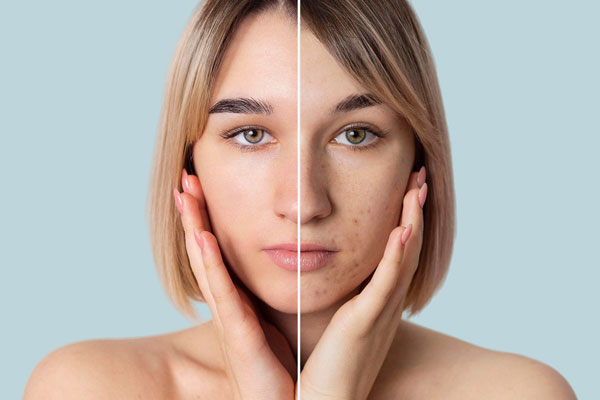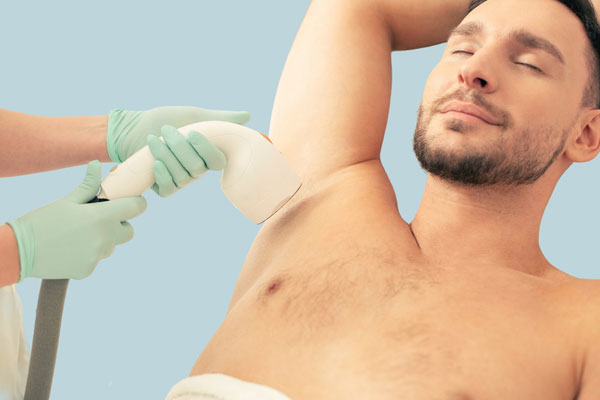Overview
What is female pattern baldness?
Female pattern baldness is a genetic and hormone-related condition that affects the normal growth cycle of hair. Each hair grows from a follicle that goes through a growth phase (anagen), a resting phase (telogen), and a shedding phase. In FPHL, follicles shrink (a process called miniaturisation), producing thinner and shorter hairs until growth eventually stops. Female pattern baldness usually causes diffuse thinning across the scalp, particularly along the parting and crown.
The condition tends to develop gradually and can start as early as a woman’s 30s, though it becomes more common after menopause. It is the most frequent type of hair loss in women, affecting around 40% by age 50.
Symptoms and Causes
How female pattern baldness appears
Female pattern hair loss typically develops in one of three patterns:
- Widening part: Hair becomes noticeably thinner along the central parting.
- Diffuse thinning: Overall reduction in hair density, especially over the crown.
- Receding hairline (less common): The hairline remains mostly intact, but some women may experience mild recession near the temples.
You may notice:
- Increased shedding during brushing or washing
- Reduced hair volume, especially near the top of the head
- Shorter, finer, or “baby” hairs replacing thicker strands
Why it happens
The main causes and contributing factors include:
- Genetics: A family history of pattern hair loss increases risk.
- Hormonal changes: Fluctuating oestrogen levels during menopause can speed up follicle shrinkage.
- Androgens: Higher sensitivity to male hormones (androgens) can shorten the growth phase of hair.
- Age: Hair growth naturally slows as we age.
- Health conditions: Polycystic ovary syndrome (PCOS), thyroid imbalance, or iron deficiency can worsen thinning.
- Medications and stress: Some medicines or severe stress may temporarily trigger hair shedding, revealing an underlying pattern of loss.
When to see a doctor
If you notice persistent thinning or widening of your parting, it’s best to consult a GP or dermatologist. Early diagnosis allows for more effective treatment and prevention of further loss.
Diagnosis and Tests
A doctor or dermatologist can usually diagnose female pattern baldness by:
- Physical examination: Assessing the pattern and extent of hair thinning.
- Medical history: Reviewing family history, hormonal changes, medications, or underlying health issues.
- Trichoscopy (scalp magnification): Used to identify miniaturised hair follicles.
- Blood tests: May check hormone levels, thyroid function, and iron stores.
- Scalp biopsy (in some cases): A small sample of scalp skin is analysed to rule out other hair loss conditions.
These tests help differentiate female pattern baldness from other causes like telogen effluvium or alopecia areata.
Management and Treatment
Female pattern baldness is a progressive condition, meaning it can worsen over time. While it cannot be completely cured, early and consistent treatment can slow or stop the progression and even promote new growth.
Non-surgical/Medical treatments
Topical minoxidil (2–5%)
- The only medically approved topical treatment for women.
- Applied directly to the scalp to stimulate follicles and prolong the growth phase.
- Results can take 4–6 months to appear and require continued use.
Oral medications (under specialist supervision)
- Low-dose oral minoxidil: Increasingly used off-label with positive results.
- Spironolactone or finasteride: Anti-androgen medicines that may reduce hormonal effects on hair follicles.
Platelet-rich plasma (PRP) therapy
- Involves injecting concentrated platelets from your blood into the scalp to encourage follicle repair and regrowth.
Low-level laser therapy (LLLT)
- Light-based treatment that can stimulate follicles and increase hair density.
Hair transplant surgery
- Suitable for women with stable donor hair and localised thinning.
- Follicular Unit Extraction (FUE): Individual follicles are harvested from the donor area and transplanted into thinning regions with minimal scarring.
- Follicular Unit Transplantation (FUT): A strip of scalp containing hair follicles is removed and divided into grafts for transplantation.
- These methods can achieve natural-looking results when performed by experienced surgeons, although outcomes depend on donor density and hormonal stability.
Cosmetic and supportive measures
- Volumising hairstyles, fibres, or wigs can help disguise thinning.
- Counselling or support groups may help with the emotional effects of hair loss.
Aftercare and Maintenance
Ongoing care includes gentle hair handling, avoiding harsh chemicals or heat, and regular follow-ups with your clinician to track progress and adjust treatment.
Outlook/Prognosis
Female pattern baldness is long-term but manageable. While complete regrowth is uncommon, consistent treatment often stabilises the condition and improves density.
Early intervention produces the best outcomes. Many women experience significant confidence improvement after successful management. The emotional and psychological impact should not be underestimated—support and professional advice are important parts of care.
Prevention
You cannot always prevent female pattern baldness, especially when genetics and hormones play key roles. However, you can take steps to protect hair health and slow progression:
- Begin treatment early at the first signs of thinning.
- Maintain good nutrition with adequate iron, zinc, and protein intake.
- Avoid tight hairstyles that strain the scalp.
- Limit heat styling and chemical treatments.
- Protect your scalp from sun damage.
- Manage stress through regular exercise, sleep, and relaxation techniques.






